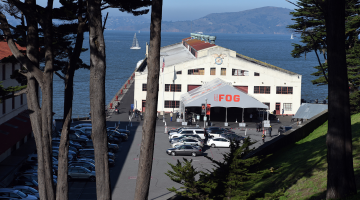“Midnight,” the Takeshi Murata show currently at Ratio 3, San Francisco includes two works: his film “OM Rider” and a hologram from the same series featuring the film’s central Teen Wolf-esque character, though the film’s soundtrack, produced by Devin Flynn, C. Spencer Yeh, and Robert Beatty, fills up the space with a tense, claustrophobic ambiance that further visual prompting might distract from. As the central focus of the show, “OM Rider” continues the artist’s exploration of New Media in the somewhat more traditional format of digital animation.
“OM Rider” is a cinematic experience, unlike Takeshi’s other digitally manipulated work, combining the high production values of today’s video games with the aesthetic tableau of classical painting captured in slower moving scenes arranged compositionally. The film’s two characters, the foolhardy, but menacing, Werewolf and a “Tales from the Crypt” type old man in a flamboyant Mafioso suit, a dark and banal netherworld, the wolf inhabiting the outdoors, the man staying inside, only crossing path once. Expectedly, it does not end well.
There’s a strong undercurrent of psychoanalysis that seems to offer the tidiest interpretation. The Werewolf, a perfect embodiment of unhampered Id and the old man, a repressive Supper Ego, not two characters at all, but rather a single personality. Though, as the show’s press release points out, it’s not entirely certain whether this reading is intended, rather it seems ambiguity is the ultimate intention.
Takeshi’s use of the horror genre does seem to reinforce a psychoanalytical interpretation, whatever it may be. Freud deemed the appeal of horror media due to a surfacing of repressed, but familiar feelings, while Jung explained the Modern phenomena of horror entertainment as coming from the name and face placing of archetypes, the primordial images of the collective unconscious revealed.
However this may apply to Takeshi’s work specifically, for an artist basing his career upon the effect of digital media and moving images on viewers, the incorporation of narrative is an interesting move and additional visceral experience for a genre that once separated itself from commercial media by eschewing plot entirely–truly something ‘new’ in New Media.
“Midnight” is on view through December 14th, 2013.
Takeshi Murata’s “Monster Movie,” 2005, will be screening as part of Art Basel Miami Beach’s Film at SoundScape Park, December 7 after 10 pm.
For more information visit Ratio 3, San Francisco.
-Contributed by Kathryn McKinney
Previous posts by Kathryn McKinney (below)
-REVIEW: “The Swimmer” solo exhibition by Chris Sollars at Steven Wolf Fine Arts, San Francisco.









